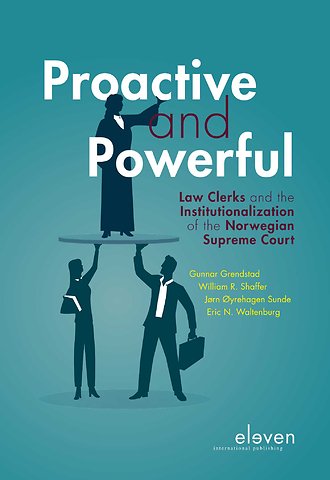Proactive and Powerful
Law Clerks and the Institutionalization of the Norwegian Supreme Court
Samenvatting
Norway’s Supreme Court is one of the most powerful Supreme Courts in Europe. This position is in large parts due to the role and expansion of the law clerks on the Court. Beginning in 1957 with a single clerk, the number of law clerks has increased dramatically. Today, the clerks outnumber the justices, and their tasks have expanded considerably.
In 1957 the task was to prepare civil appeals. Today, clerks assist in most stages of the Court’s decisional process, including the writing of the final decision. The expansion and institutionalisation of the clerk unit have enabled the justices to commence on policymaking and on developing the law. The law clerks have been key in the development of a more proactive and powerful Norwegian Supreme Court.
This book is the first comprehensive study of law clerks in a European Supreme Court. It will be valuable to lawyers, historians and political scientists who care about the expanding role of courts and the impact of courts on politics, society, and the legal system.
Trefwoorden
Specificaties
Inhoudsopgave
List of Tables xvii
Preface 1
Acknowledgements 3
1 A Master Plan 7
1.1 Hit the Ground Running 9
1.2 The Growth of Law Clerks 11
1.3 Institutionalization 13
1.4 Plan of the Book 17
1.5 Appendix: Timeline – Clerks, Justices and Gatekeeping in the Norwegian Supreme Court 18
2 The Structure and Organization of Decision-Making 23
2.1 Prelude: Four Groups of Five Justices 23
2.2 The Appeals Selection Committee – The Gatekeeper 24
2.3 Oral Arguments 27
2.3.1 Grand Chamber and Plenary Sessions 31
2.4 Deliberations 32
2.5 Opinion Writing 34
2.6 Enter the Clerks 36
3 “… Like Ordering Soldiers toward a Shower of Bullets” 39
3.1 Caseload and Backlog 39
3.2 Demonstrating the Potential 42
3.3 Demands for Efficiency, Sacrificing Saturdays 43
3.4 The Court Turns Down an Offer for More Clerks – ‘A Year of Crisis’ 44
3.5 Something Has Got to Give 47
3.6 “… Ordered toward a Shower of Bullets” 48
3.7 ‘No Clerks in the Courtroom’ 50
3.8 Flaunting Power: The New Palace of Justice 52
3.9 The Purge and the Soft Backlash 54
3.10 Mentoring Clerks – From Buddy to Front-Loading 55
3.11 New Chief, New Broom 58
3.12 A Momentum for Clerks 59
3.12.1 Forward-Looking – The Development of the Law 59
3.12.2 Outward-Looking – The Internationalization of the Law 61
3.13 Still a Shortage of Clerks 62
4 The Court’s Gatekeepers 65
4.1 The Supreme Court’s Processing of Appeals 66
4.1.1 An Appeal Arrives at the Court 67
4.1.2 Prioritizing the Appeals 68
4.2 Six Principles of Deciding to Decide 69
4.2.1 Two Statutory Revisions 73
4.3 The Appeal Arrives at the Clerk Unit 74
4.4 The Clerk Scrutinizes the Appeal 75
4.4.1 The Formalities 76
4.4.2 The History of the Case 79
4.4.3 The Parties’ Arguments and the Legal Forces 79
4.4.4 The Clerk’s Recommendation 80
4.5 Deciding to Decide 82
4.6 The Appeal Is Granted Review and Prepared for Oral Arguments 85
4.7 Inching towards the Next Level 86
5 “A Weakness of the System” 89
5.1 Fine-Tuning the Clerk Unit 90
5.1.1 Complementing the Litigants Only 92
5.2 Legal Complexity Starts to Tax the Justices 92
5.3 Breaking Another Barrier 95
5.4 Securing His Legacy 98
5.5 The Gavel Has Been Passed 101
5.6 The Øie Court 106
5.7 Quality 107
5.8 Institutionalizing the Clerk Unit – Never a Reversal 108
6 Who Are the Law Clerks? 111
6.1 Female Clerks 112
6.2 Age 116
6.3 Law School 119
6.4 Tenure 121
6.5 Diversity 123
6.6 Approaching Representativeness 126
7 The Development and Impact of Law Clerks 129
7.1 The Growth of the Clerk Unit 130
7.2 Explaining the Growth of the Clerk Unit 134
7.3 Clerks and the Transformation of the ASC 139
7.4 The Effects of the Institutionalized Clerk Unit 140
7.4.1 Institutionalism and Merits Review 141
7.4.2 Institutionalism and Legal Grounding of Opinions 143
7.4.3 Institutionalism and Non-unanimous Decisions 150
7.5 The Growth of the Law Clerk Unit Matters 152
7.6 Appendix A 154
8 A Nordic Comparative Perspective 155
8.1 The Nordic Legal Family 156
8.2 Courts of Precedent 157
8.3 The Clerking Framework 160
8.3.1 The Number of Clerks 160
8.3.2 A Pool of Clerks and Specialization 162
8.3.3 Qualification Criteria 163
8.4 The Task of the Clerks 165
8.4.1 Iceland 165
8.4.2 Denmark 166
8.4.3 Sweden 168
8.4.4 Finland 169
8.5 Conclusion 171
9 Conclusion: Clerks Count, Justices Decide 173
9.1 Building a More Powerful Court 173
9.2 The Supreme Court as a Political Actor 180
10 References 185
Index 197
Anderen die dit e-book kochten, kochten ook
Rubrieken
- cadeauboeken
- computer en informatica
- economie
- filosofie
- flora en fauna
- geneeskunde
- geschiedenis
- gezondheid
- jeugd
- juridisch
- koken en eten
- kunst en cultuur
- literatuur en romans
- mens en maatschappij
- naslagwerken
- non-fictie informatief/professioneel
- paramedisch
- psychologie
- reizen
- religie
- schoolboeken
- spiritualiteit
- sport, hobby, lifestyle
- thrillers en spanning
- wetenschap en techniek
- woordenboeken en taal









